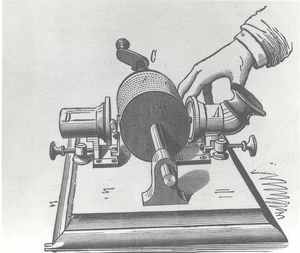Phonograph
Thomas Edison’s original phonograph was intended to be a telephone recorder. Edison thought that sound recording would be popular in business, just as the telephone was popular in business. He had already invented a high speed “recorder” for the telegraph that wrote its dots and dashes on a strip of paper. He thought that a record of telephone conversations would also be useful.
The first experimental recordings of sound that Edison made at his Menlo Park laboratory were done on a strip of paper coated with wax. He attached a recording stylus to a telephone receiver and let the vibrations of the receiver carve a groove into the wax. When he replayed the record, he could almost make out the original sounds.
However, continued experiments with recording the telephone did not result in a satisfactory sound recording machine. Instead, Edison tried to record sound directly from the air. After trying several different ideas, Edison’s assistants constructed something that was like a modified version of the phonautograph, a scientific device for recording sound waves on paper or glass. This was the first cylinder phonograph, a machine that embossed the sound record in a groove on a thick sheet of tin foil.
Using ideas he mentioned in a patent for telephony improvements filed on 30 July 1877 (the recording of sound by transverse indentations in a v-shaped groove in a paper tape or on a sheet of tinfoil wrapped on a cylinder), Edison drew a sketch for the phonograph on November 29th, 1877 that was used to make a working model a few days later.
In December of 1877, Edison’s machinist presented him with the completed prototype. Edison leaned toward the recording horn and shouted out the words “Mary had a little lamb, it's fleece was white as snow, and everywhere that Mary went, the lamb was sure to go.” It was hardly a moving speech, but then nobody—not even Edison—expected the machine to work the first time. To his great surprise, a highly distorted but recognizable version of Edison’s words spilled out of the machine when the tinfoil was cranked under the needle once again. The device was demonstrated to Scientific American on Dec. 7th; Edison filed for a patent on Dec 15th and the invention was announced publicly in Scientific American on Dec. 22nd.
That first recording, along with many subsequent test recordings made in 1877 and 1878, are now lost. In a letter, one of Edison’s employees mentioned that plaster casts were made in 1878 of some records, and that the casts were going to be used to make copies. Unfortunately, nearly all these early tinfoil records are lost except for a few, and they have never been played. They are stored in the Edison National Historic Site in New Jersey. The earliest existing cylinder recordings date from almost ten years later, after Edison had introduced his greatly improved “wax” cylinders.


